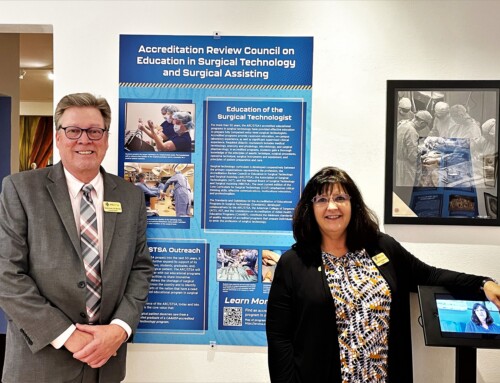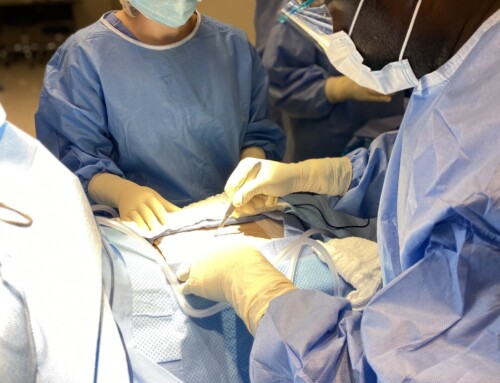An Interview With Amy Broussard, AAS, CSFA, CRCST, CST, FAST, by Terry M. Herring, Ed.S, COA, CSFA, CSIS, CSPDT, CST
Disclaimer: The resources in this article are shared for informational purposes and not intended as a promotion or product endorsement by the ARC/STSA.
Advances in technology have made surgical simulation a powerful teaching tool, and there are many options that can apply to surgical technology. Terry Herring, surgical technology division chair at Fayetteville Community College, spoke to Amy Broussard, program director and lead instructor at SOWELA Technical Community College, about one such simulation technology, PeriopSim.
Broussard shared how the technology has played a significant role in keeping her students engaged, allowing them to hone their skills and safety practices during remote learning, and how it enables instructors to quickly identify knowledge gaps, preventing issues from becoming “bad habits.”
Why did your program decide to start using PeriopSim?
Our program had a cohort that was two months from graduation when the COVID-19 pandemic ramped up in March 2020. Like other surgical technology programs across the country, our clinical affiliates would not allow students in the surgical facilities, and all elective procedures were canceled. This forced the college to pause all clinical courses indefinitely and convert lecture and lab courses to an online delivery format. I was desperately searching for a simulation or virtual reality (VR) platform that would keep surgical technology students engaged and active. Students needed a system they could use at home to help them practice and retain the skills they needed for their upcoming certification exam.
We knew we needed a simulation model, but the ones I knew of were for nursing concepts or medical residents, not allied health professions — until I heard about PeriopSim.
The PeriopSim application was exactly what I was looking for. It provides surgery procedures and instrumentation learning modules based on safety and skill, evidence-based practices in modern-day procedures and, more importantly, relevant information that surgical technology students learn and use in everyday practice.
When our state was hit by two major hurricanes in August and October, shutting down our main campus for six weeks, our program once again turned to PeriopSim. Synchronous meetings were not possible since the area was recovering and internet service and power were still being restored in some areas. Students could log on whenever they were able during those six weeks and complete the modules. I could watch their progress through the educator’s portal during that time, too, and I was able to see how they scored along the way each time the module was completed. There was a definitive upward trend in their performance score, and use of the quantitative assessment “grade” to verify their competency was being addressed.
What feature of PeriopSim stood out to you the most?
The most remarkable aspect of PeriopSim is, in my opinion, the VR system. Students can use the 2D system from wherever they are and continue to improve or retain what they know, but the VR system takes this learning to a whole new level.
When I received a demo version, the first thing I noticed was that the system was completely plug-and-play. I am not an IT expert, and my experience level at best is moderate. However, I followed the easy steps listed, plugged in the headset and it worked!
I was transported into an OR room that was as real to me as if I was scrubbing in a real OR. I had to pick up instruments in the correct orientation, pass them smoothly using safety practices, respond in a reasonable amount of time and anticipate what the next request would be. If I dropped an instrument or handed it with incorrect orientation, the system deducted points. I was given visual clues by the surgeon’s hands turning red, yellow or green, and I could see the procedure on the monitor above the surgical table just like boom monitors in an OR.
Have you seen an increase in student engagement?
Absolutely. Faculty in the program assign students different types of activities that are graded. By far, the assignments we have implemented involving the PeriopSim system have been completed on time and without complaint from students.
More importantly, these assignments have been an effective learning tool for our instructors. The system can generate reports that faculty can use to tailor lab instruction and address concepts or situations with individual students or the group as a whole. We can identify these issues before students take any exams or even enter a clinical site.
PeriopSim is able to deliver immediate visual and verbal feedback, as well as a complete session debriefing when the module is over. Students do not have to wait for faculty to review a performance video. They can change the issue independently, which alleviates the demand on faculty members’ time. We can address them in the lab and correct issues before they become bad habits.
How did your program pay for PeriopSim?
The 2D module at home was a flat fee for one-year access for up to 20 students. This year’s fee was provided to students with grant funding in response to the pandemic, and we used this system for both the surgical technology and sterile processing students during the stay at home order. However, the cost is affordable and one that, in future classes, we will continue to use the system and divide the cost up by students and include it in their fees.
I submitted a request for Carl Perkins (Title IV) funding for the VR system. Different system options will determine the cost (mobile unit vs. computer stationary unit). We chose the mobile VR system that we can use with our students to allow for social distancing. Later, it can be taken out into the community to educate the public on what surgical technologists actually do and promote the program.
Editor’s Note: The education funding streams in the Coronavirus Aid, Relief, and Economic Security (CARES) Act may cover a range of medical simulation training technologies. Funding for resources such as this is also available through the Carl D. Perkins Career and Technical Education Act of 2006 (Perkins IV)



